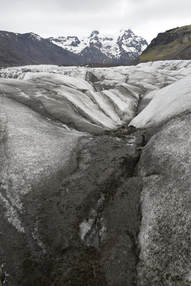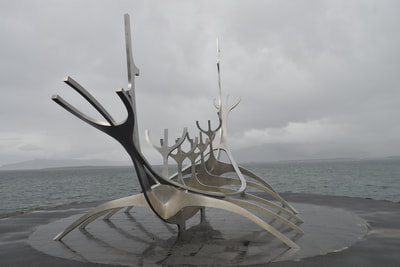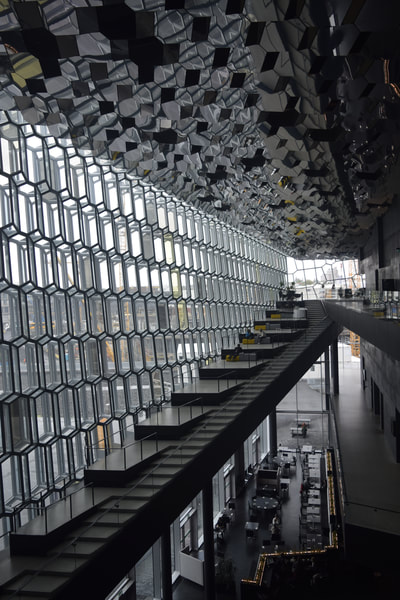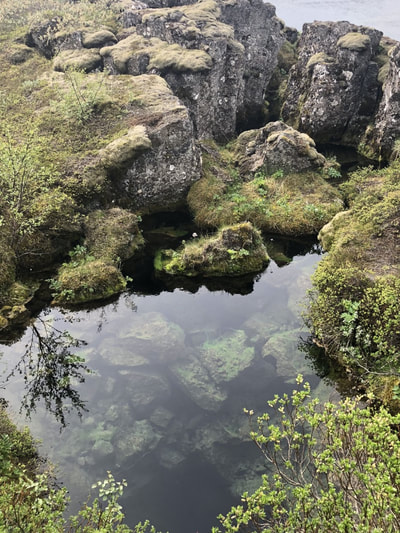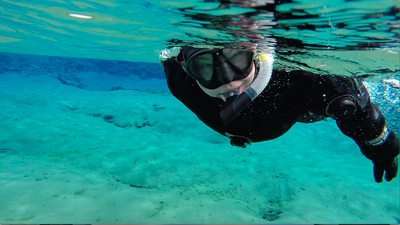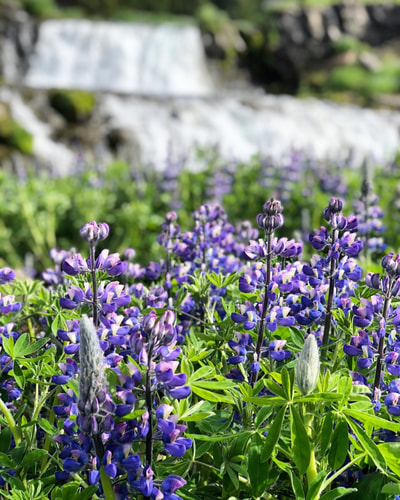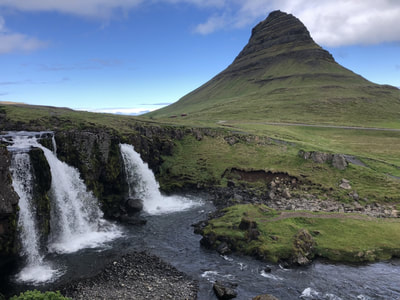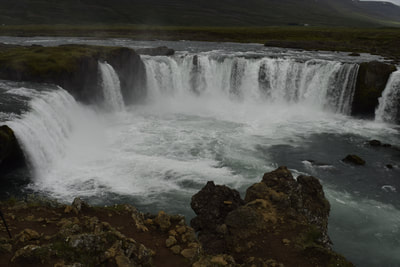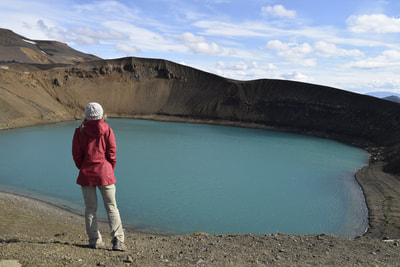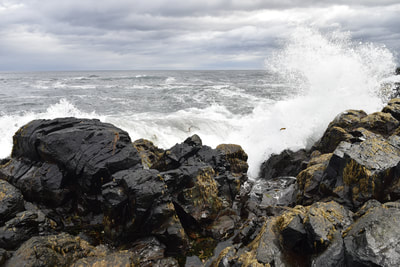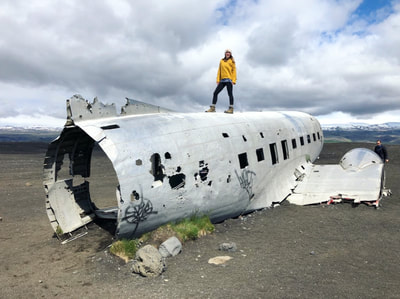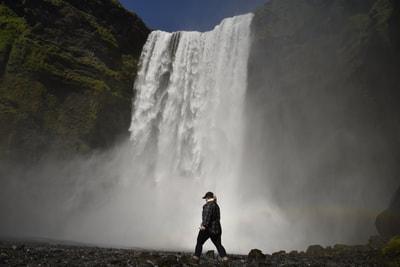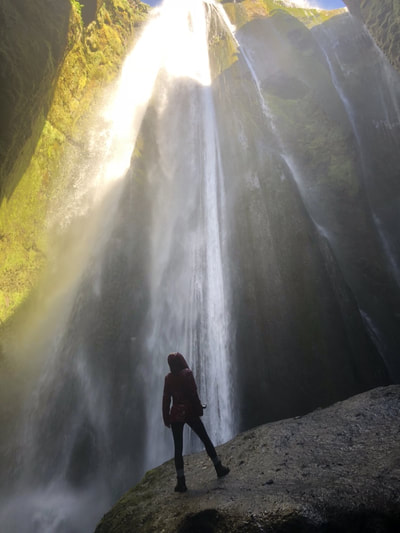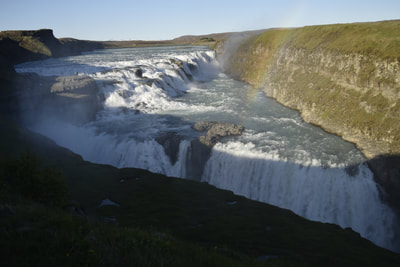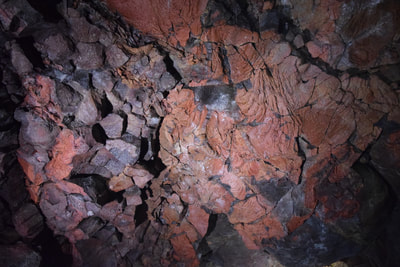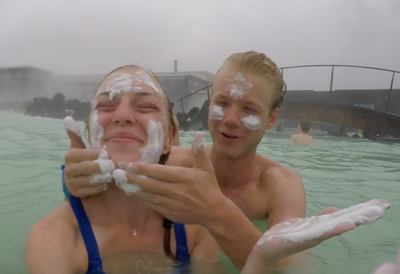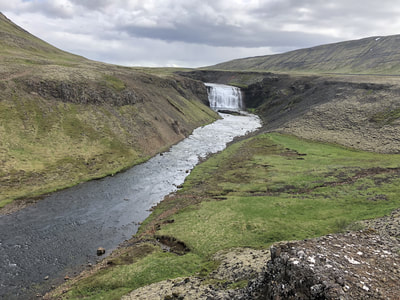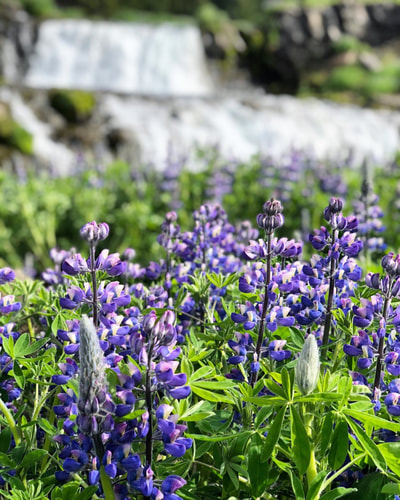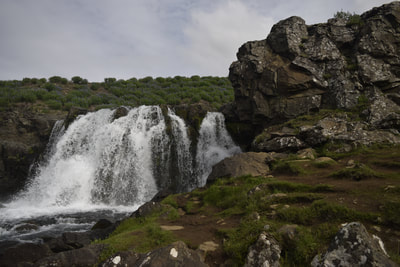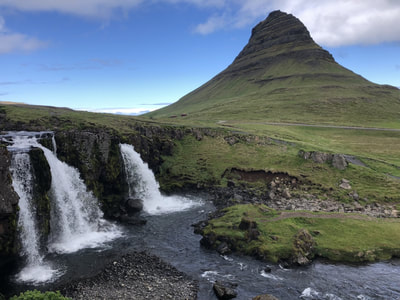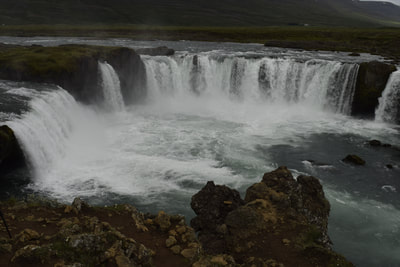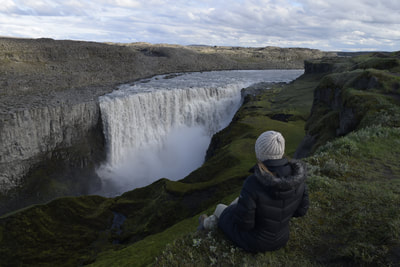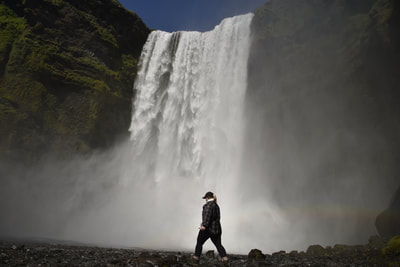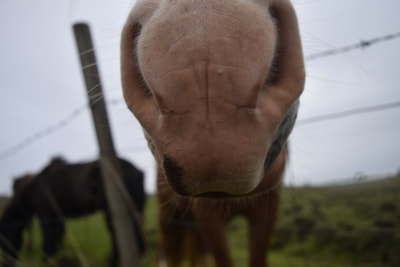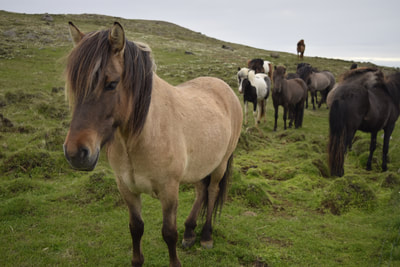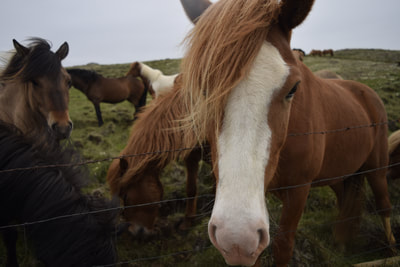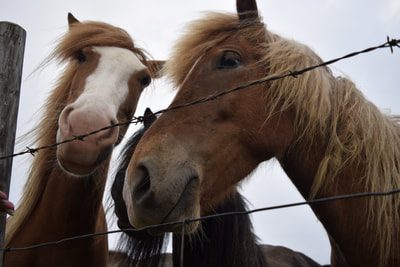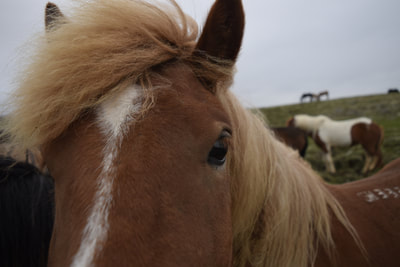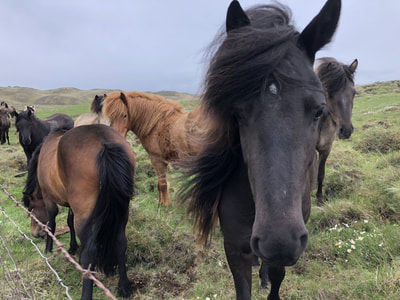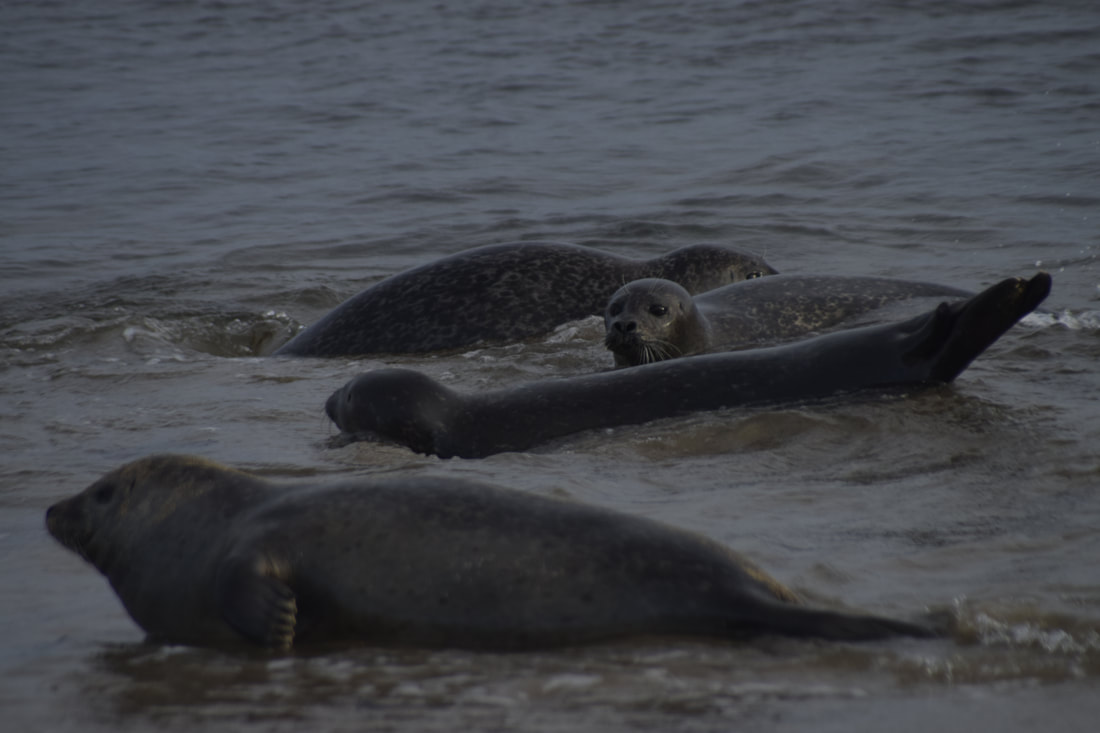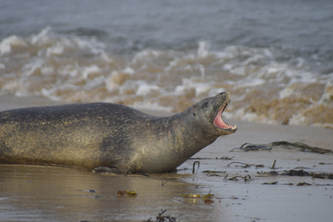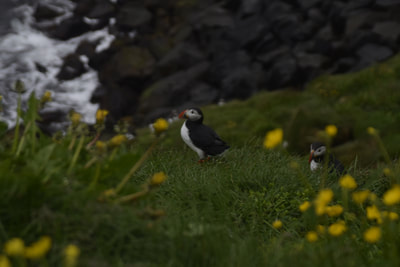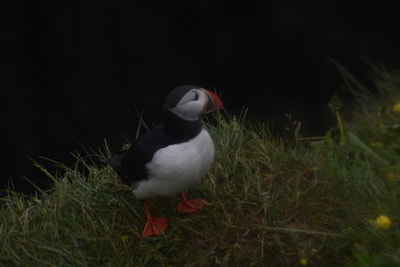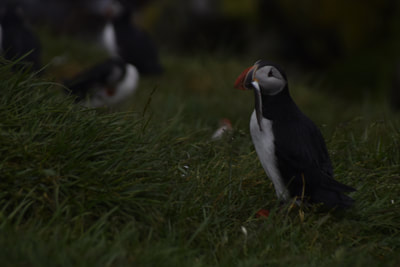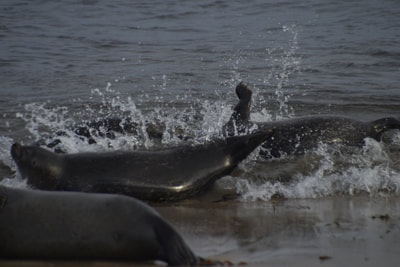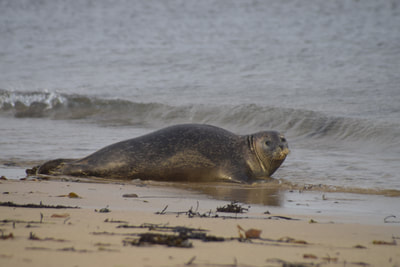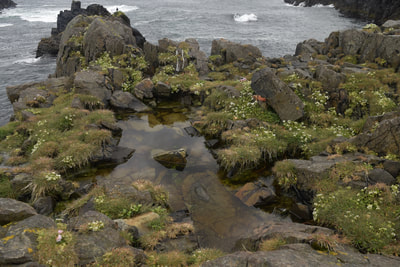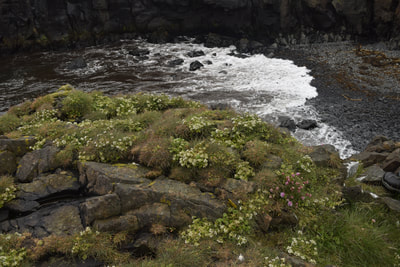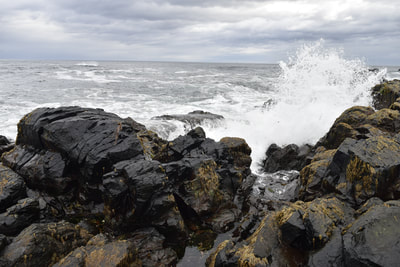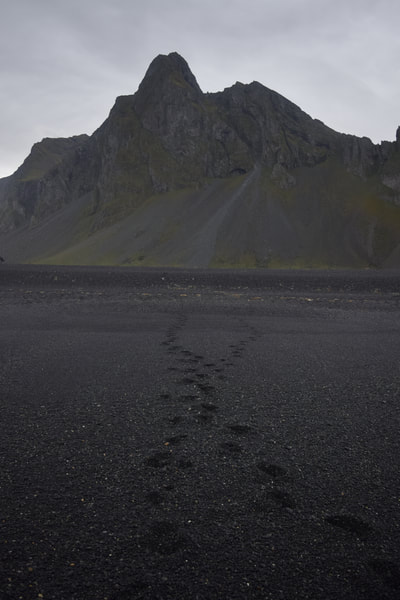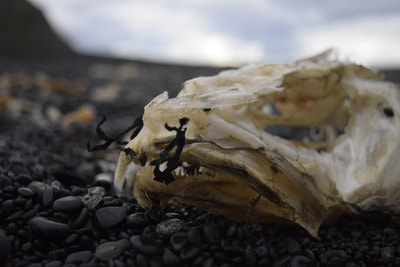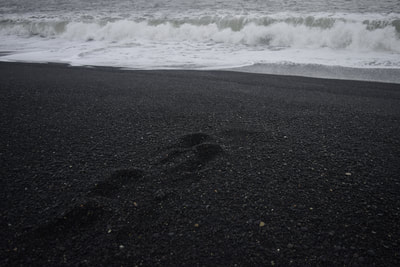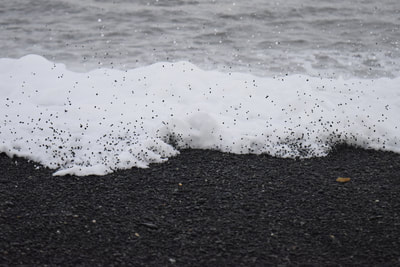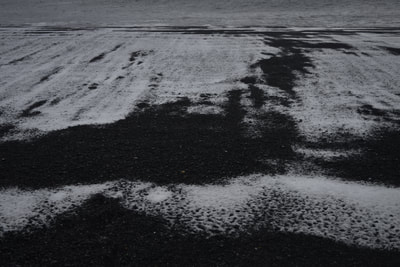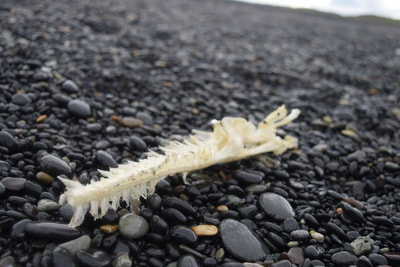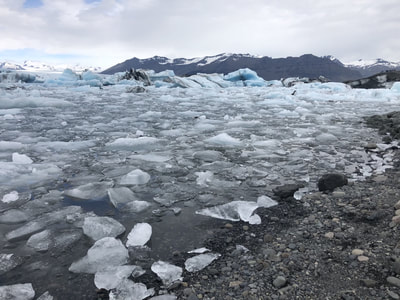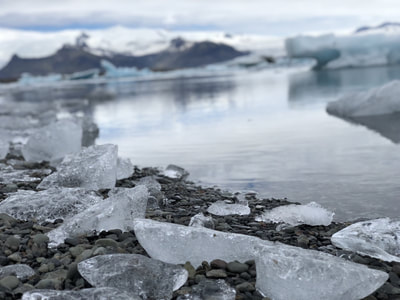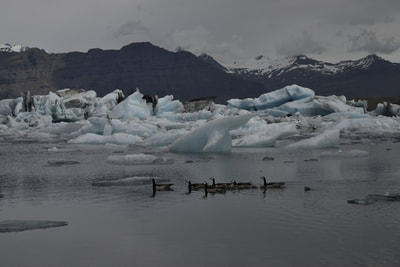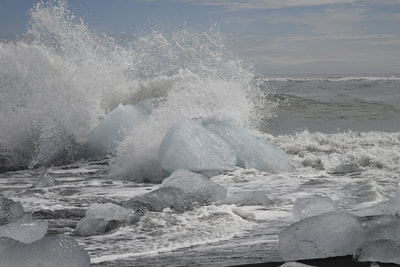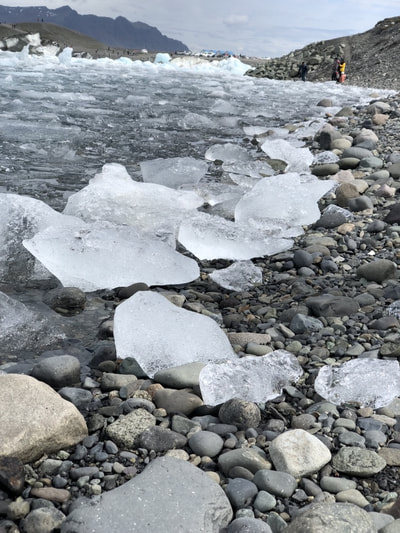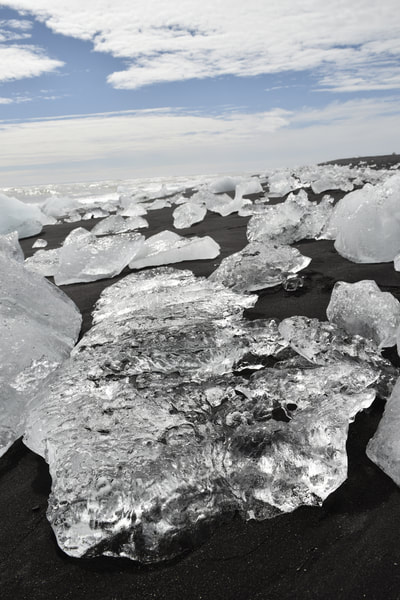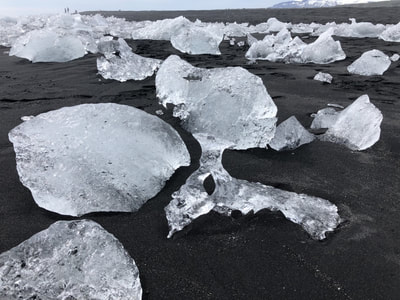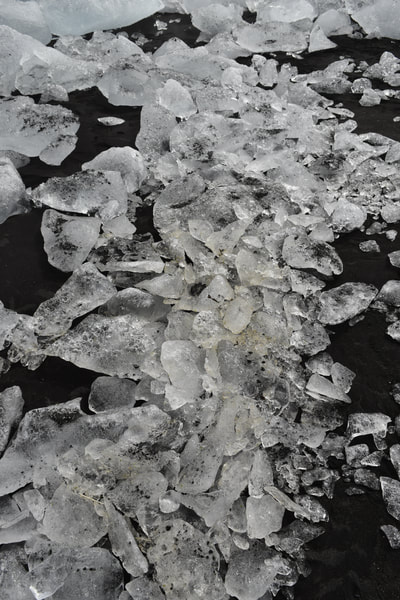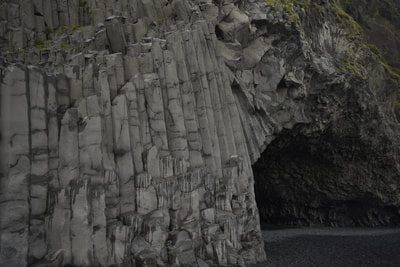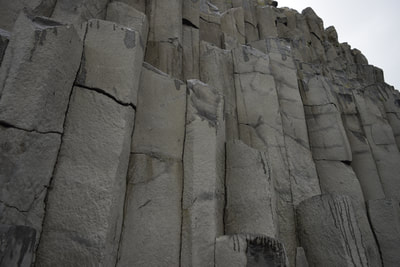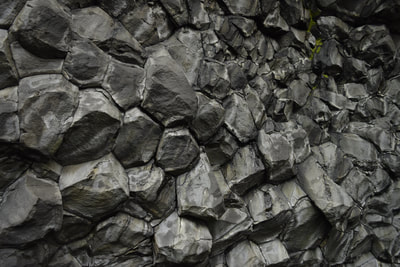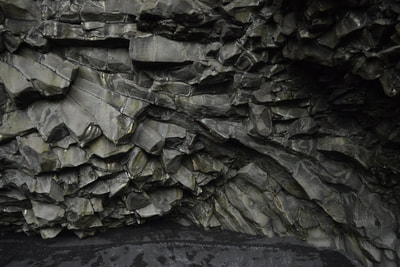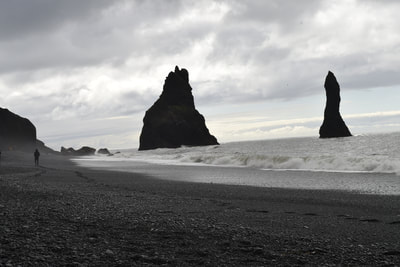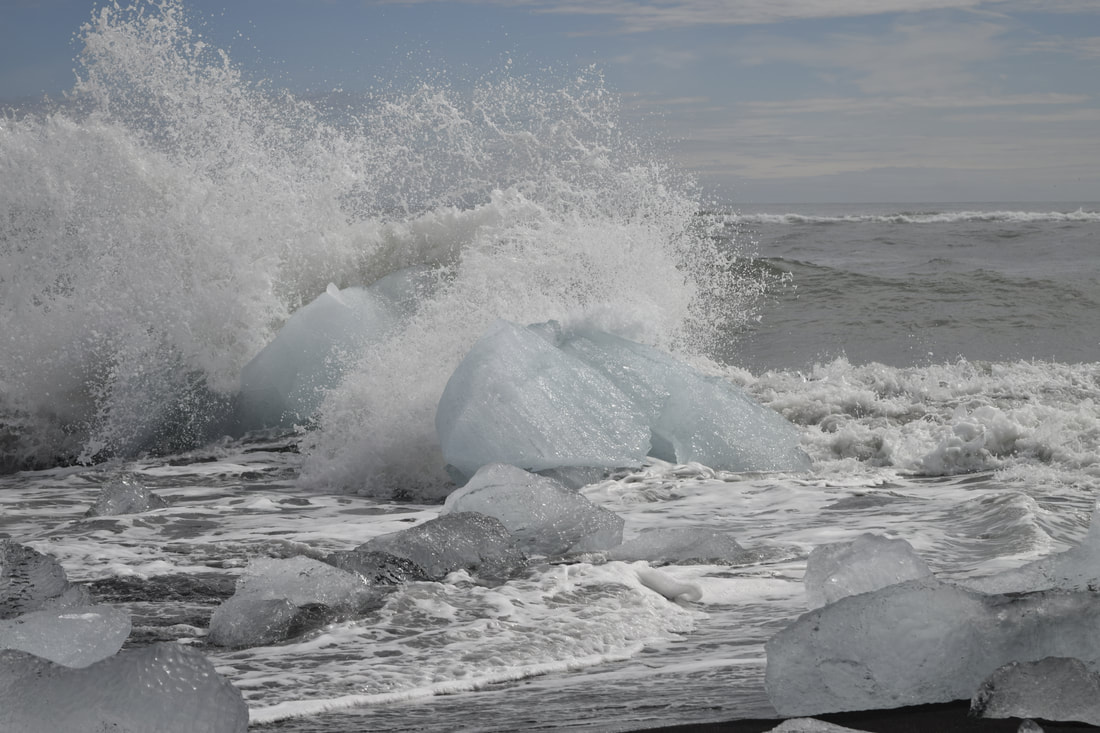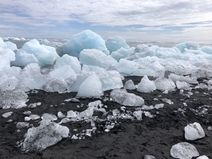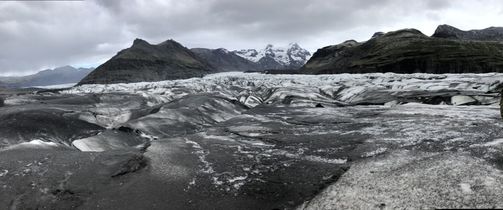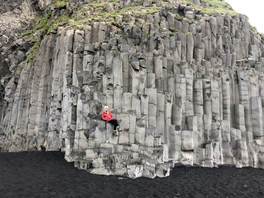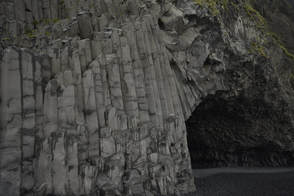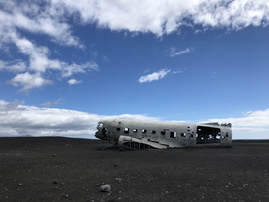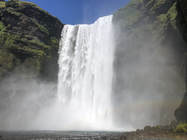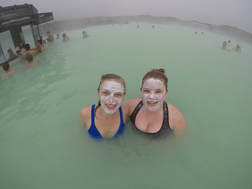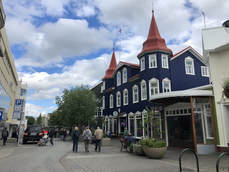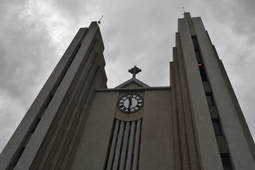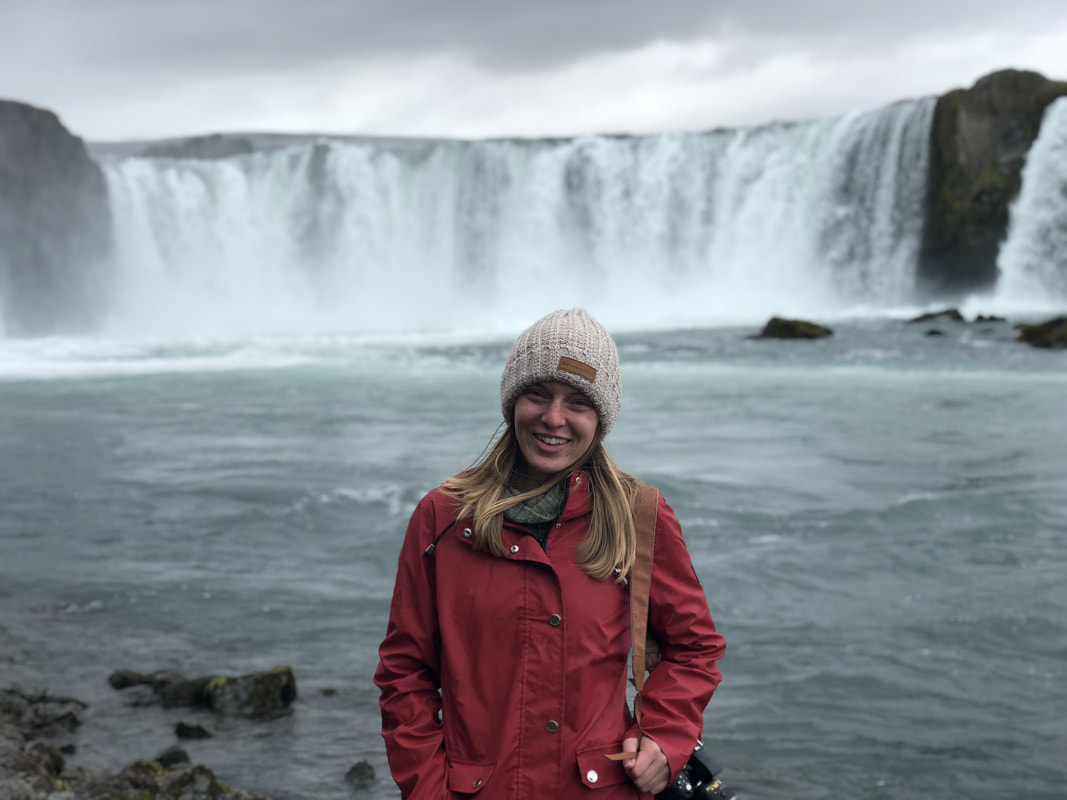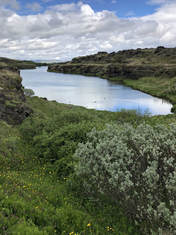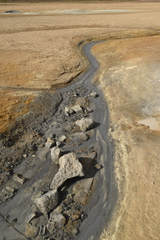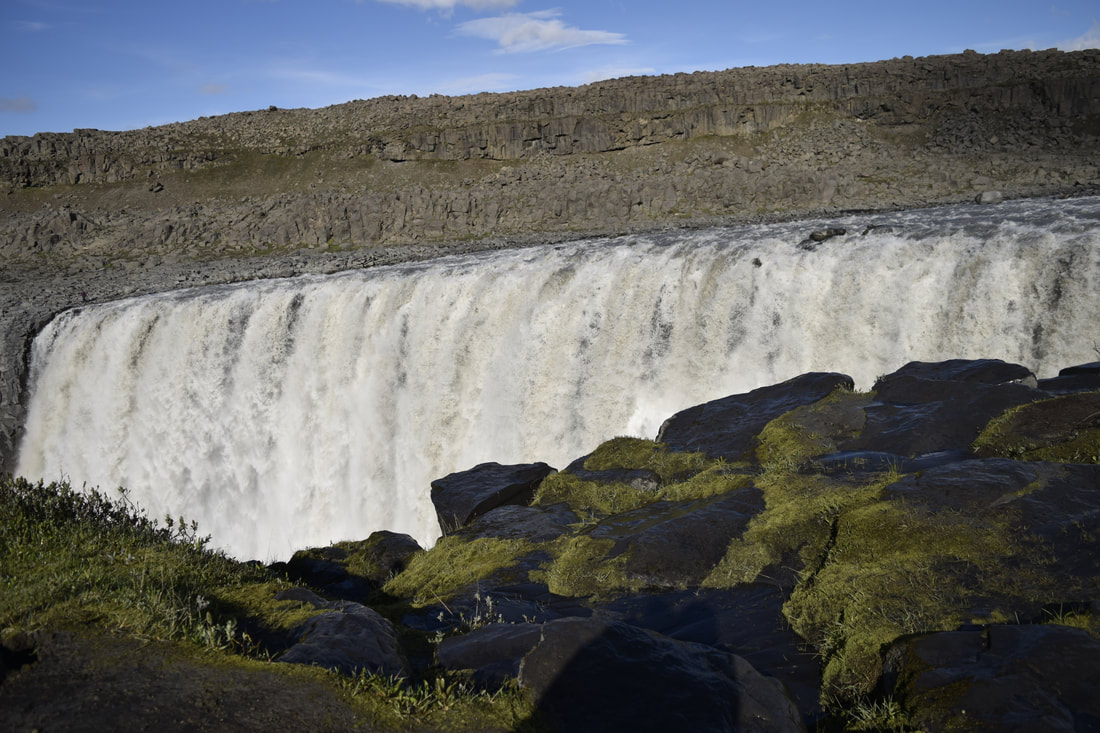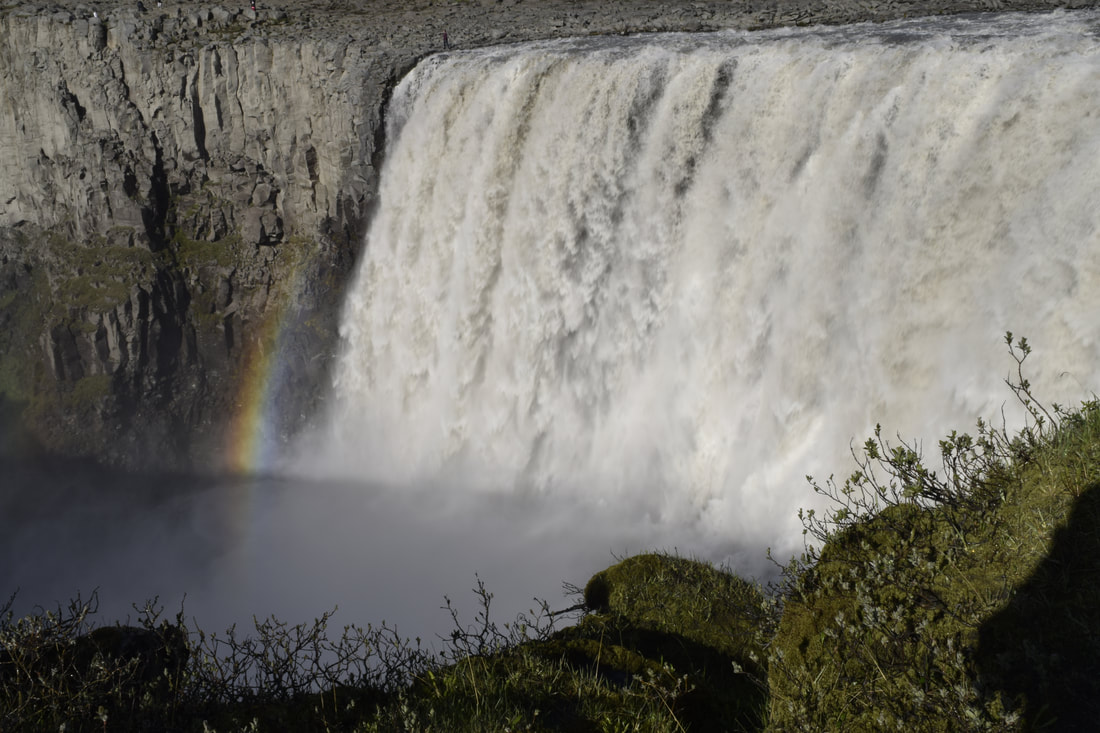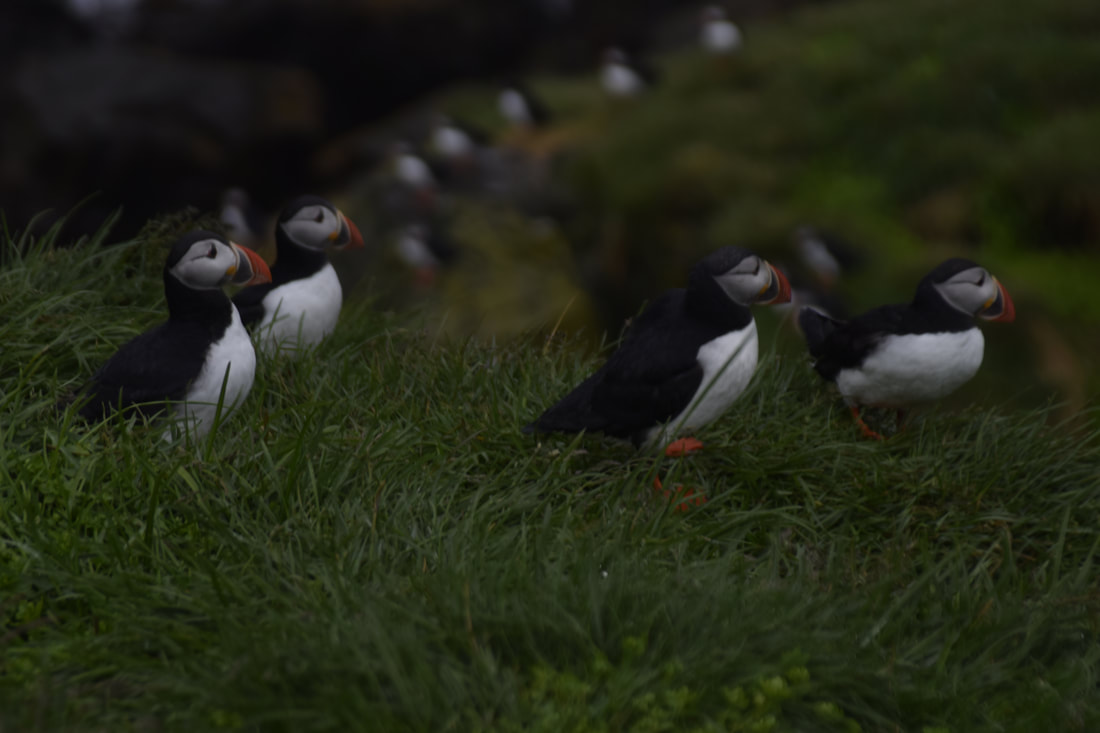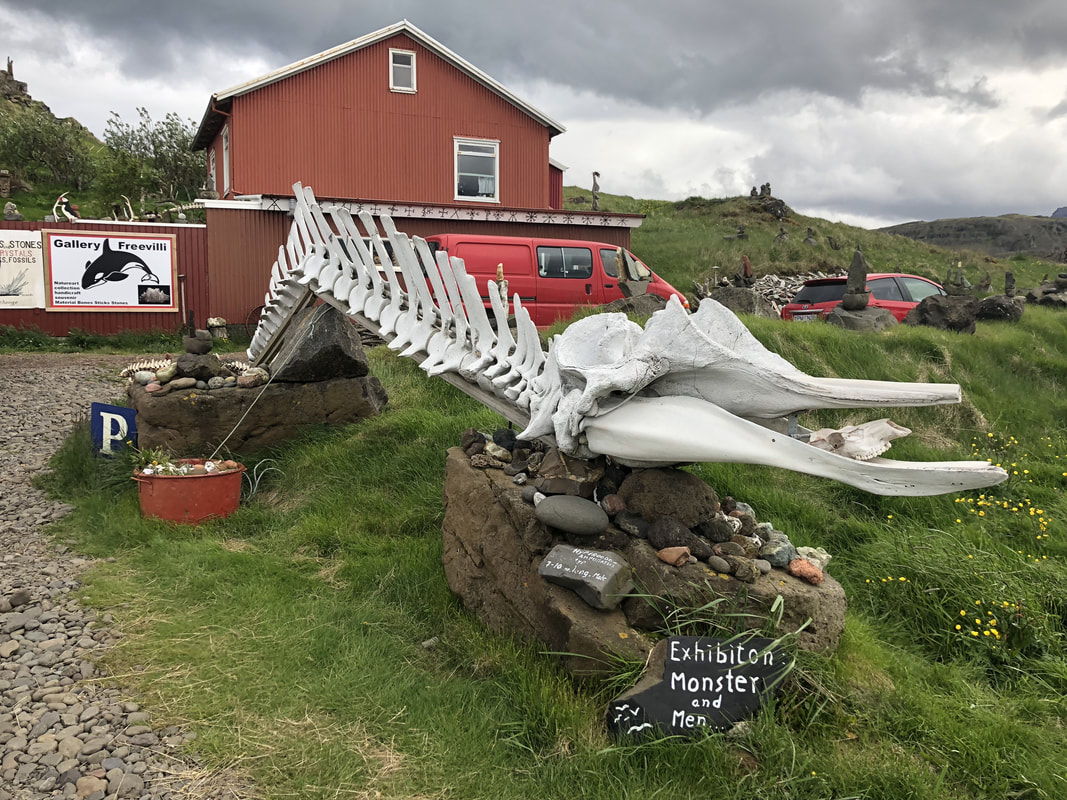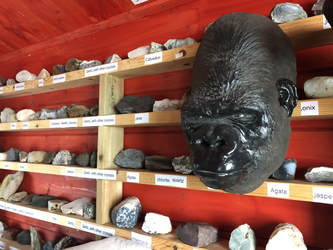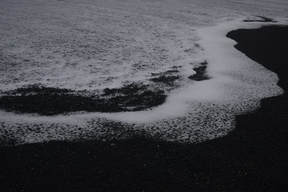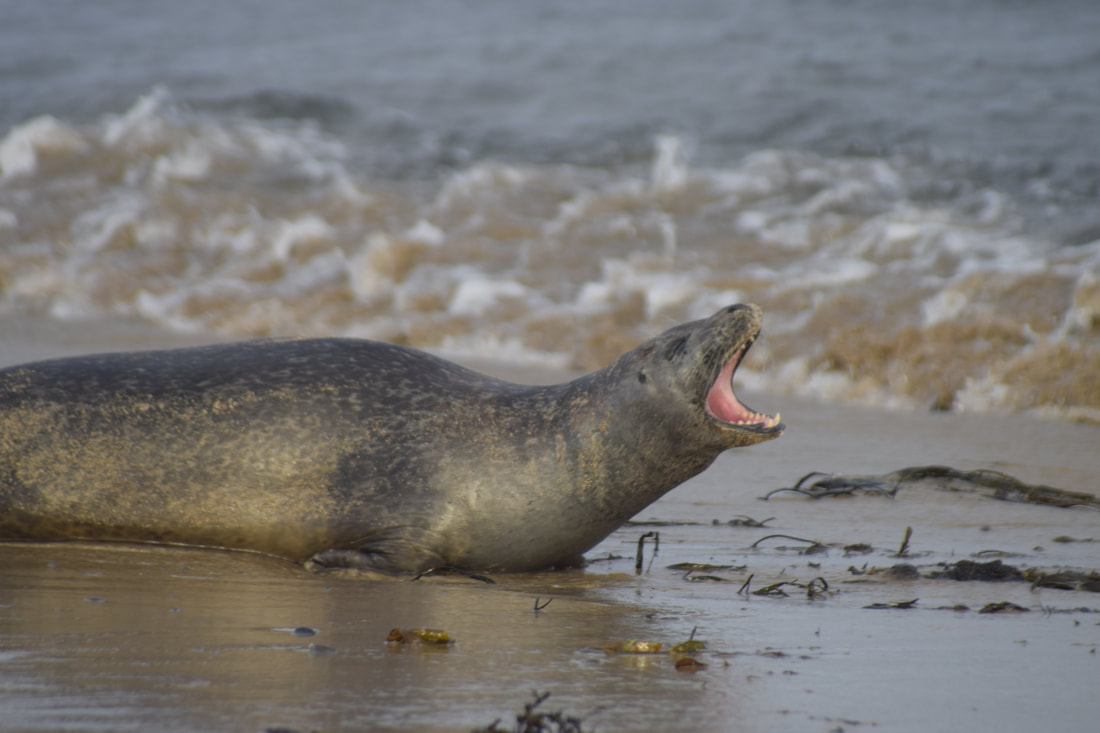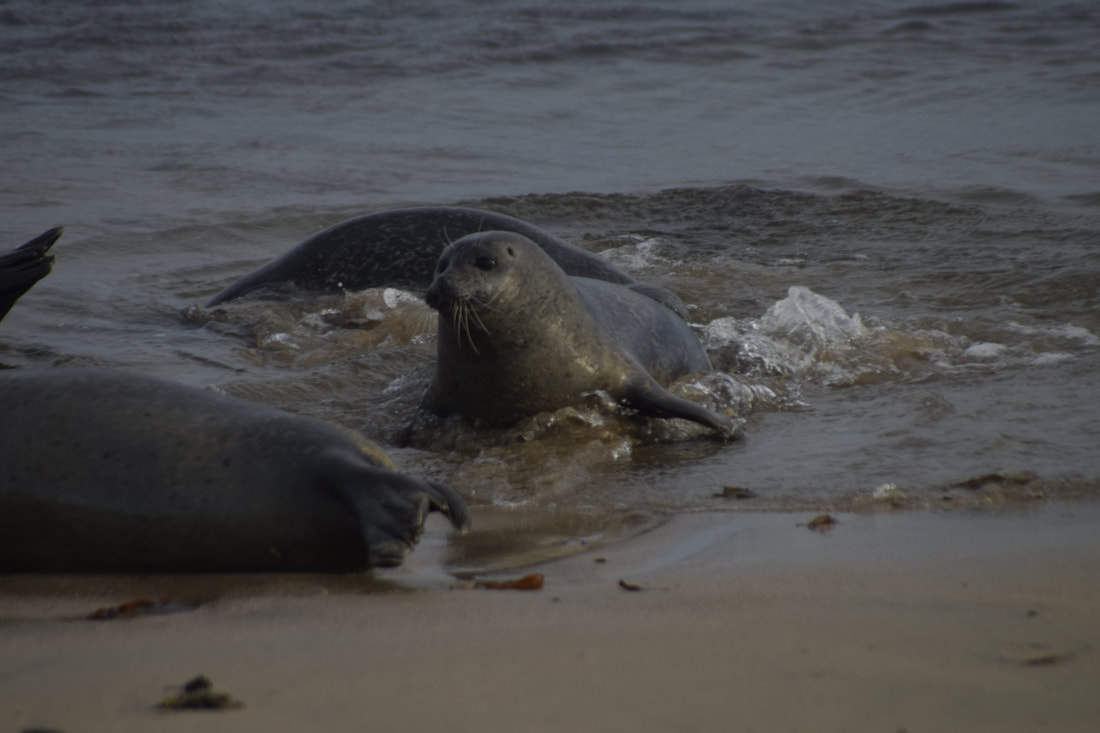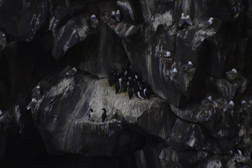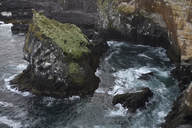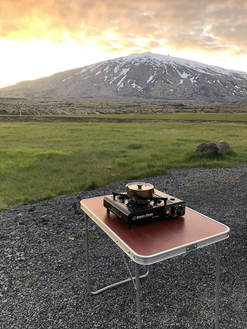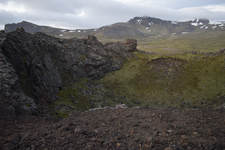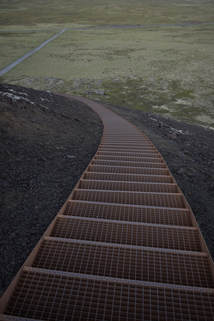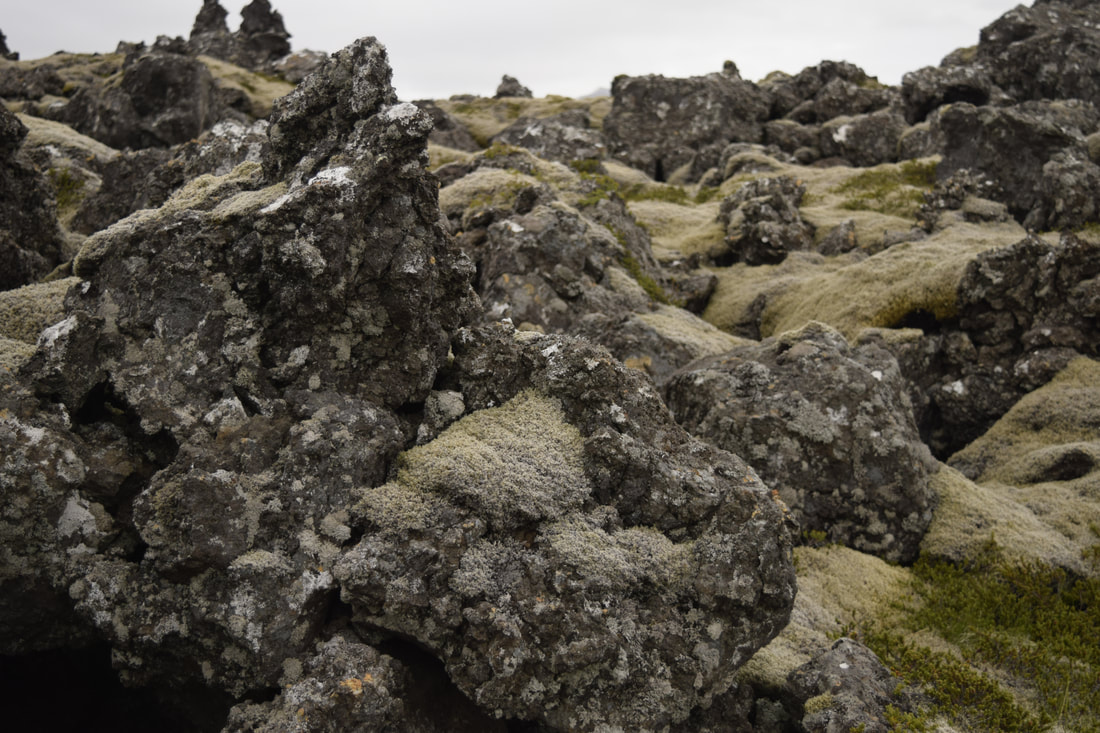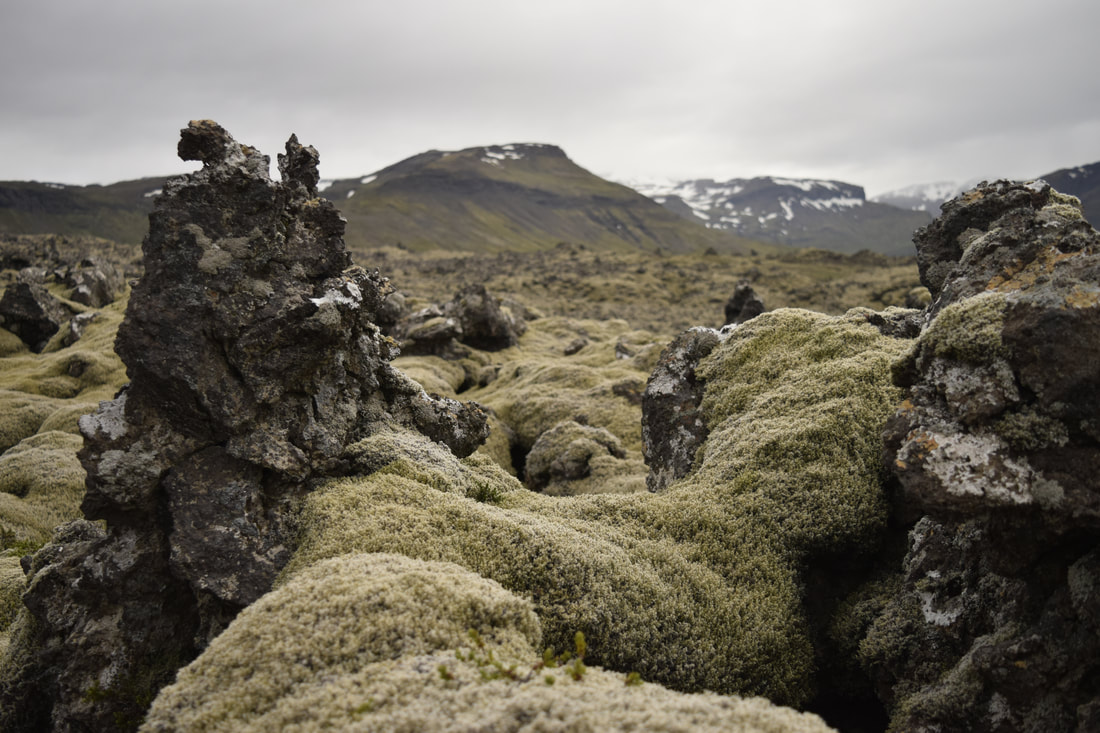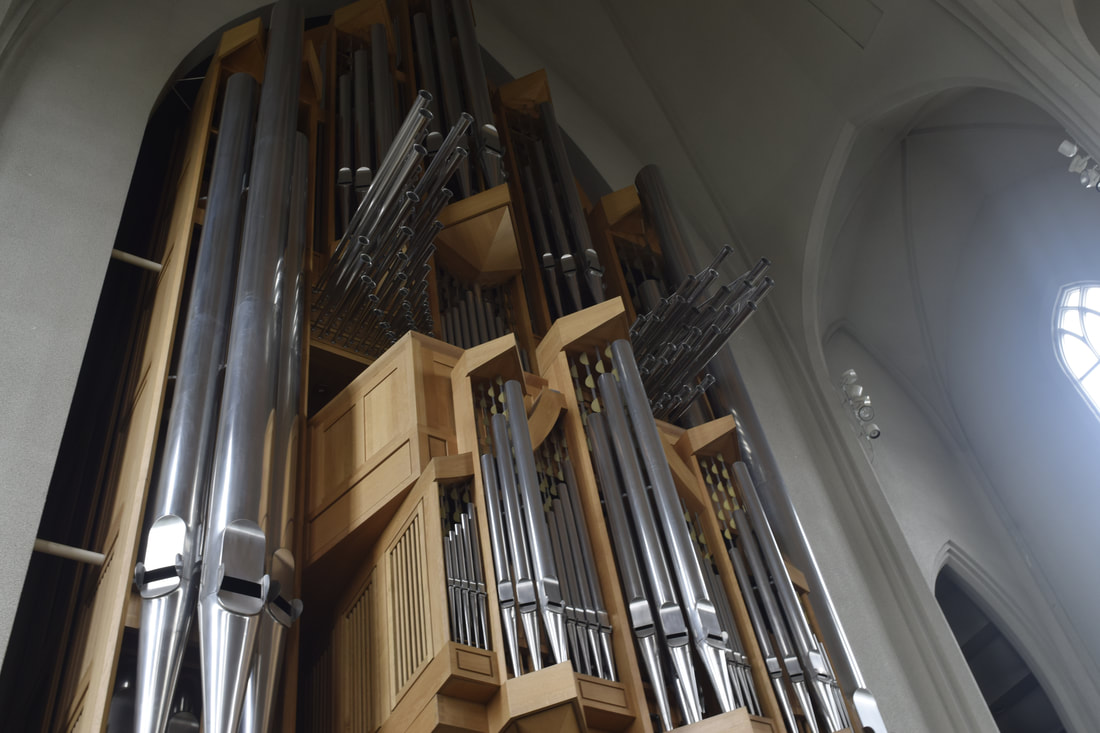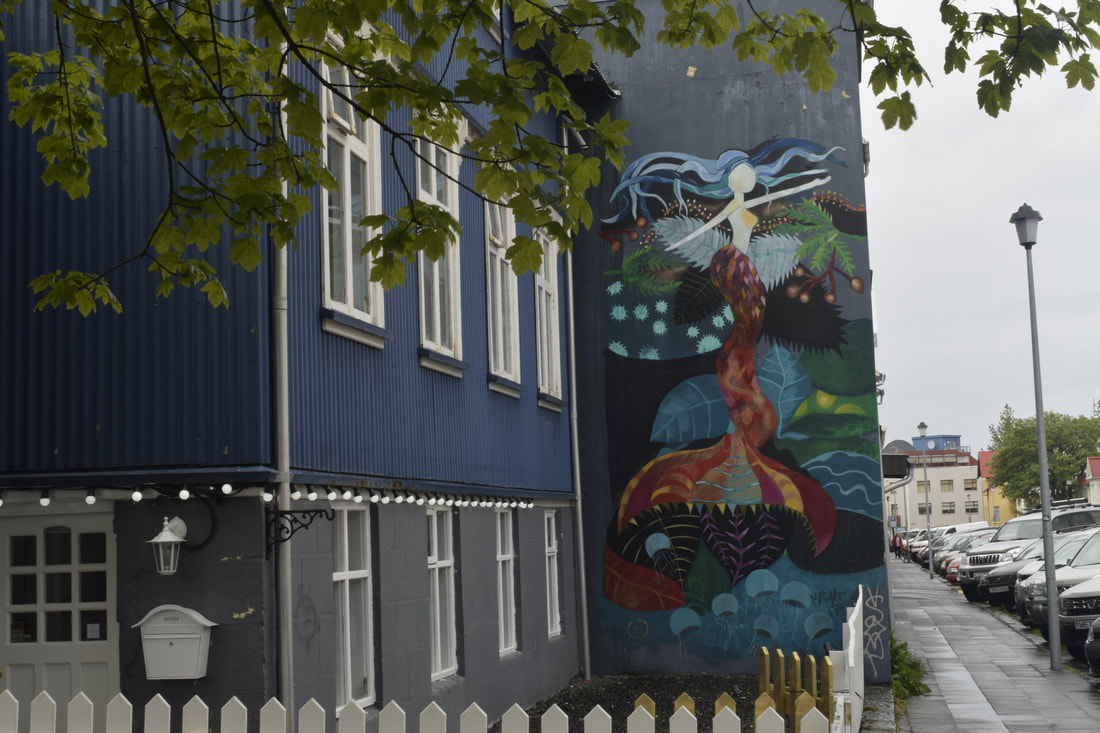 Iceland is an island of natural contrast. An ancient ocean gnaws at young land, water and ice carve through volcanic rock, and sprawling green-fields are shadowed by snow-capped peaks. I could not have imagined how stunning Iceland would be nor could I have anticipated the wonder it would inspire.  It is estimated that the first land to emerge in the place we know as Iceland did so 12-14 million years ago. This new surface would continue to grow in spite of the raging ocean around it. Jagged island spires, iconic detachments of rock, and heavily weathered cliff faces are all evidence of the ongoing oceanic attempt to subdue this mass of defiant land. The struggle between rock and water can be seen inland as well. The country’s glaciers and rivers are antithetical to the volcanic rocks they inhabit. The masses of ice grind away layers of rock as the oldest ice is forced down along the slopes, and rivers of melt-water simultaneously shape steep cliffs and mountainsides at every turn. These landscaping forces eventually provide the life-sustaining freshwater streams that permeate Iceland’s lowland areas. 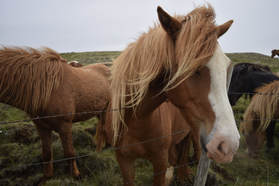 Sheep and shaggy Icelandic horses enjoy the resulting green-fields. The expanse of pastures separate small coastal towns and feature the occasional farm, church, or community. Virtually all of these lowlands exist at the feet of towering mountain ranges. These behemoths are summer sanctuaries for persisting snow, and they shine like beacons in the sky for travelers. Taylor, her sister Kendall, and I saw all of this beauty as we drove and camped around Iceland’s ‘Ring Road’ or Route 1. The route more-or-less parallels Iceland’s shoreline and encircles a majority the country. We did venture off the Ring Road to explore the Snӕfellsnes Peninsula and find puffins in Borgarfjarðarhöfn. The entire trip took eight days and nearly 1,000 driving miles. Here’s how we did it: Day One: We arrived at Keflavík Airport and took a cab to the Airbnb where we were staying. We then took the bus to Reykjavik to see Hallgrimskirkja Church, the Sun Voyager Structure, Harpa Concert hall, get hot dogs at Bajarins Beztu Pulsur, and have drinks at The Lebowski Bar. Day Two: We picked up our Kuku Camper and went snorkeling at the continental divide at Silfra. We then drove to the Snæfellsnes Peninsula and cooked dinner under a midnight sun before camping at the Hellissandur Campsite. Day Three: We went to see Kirkjufellfoss before catching Iceland’s first World Cup game at Laki Hafnarkaffi. After a tie game, we explored around Berserkjahraun Lava Field, admired the horses at Vatnsdalur, and called it a night outside of Akureyri. Day Four: We started the day on the North Coast by walking through Akureyri before checking out some of Europe’s most powerful waterfalls, Detifoss and Godafos. We then swam in Stóragjá and walked through the sulfuric acid fields of Hverir near Lake Mytavn. Day Five: We drove off the Ring Road to Borgarfardarhöfn to see hundreds of puffins before following the shore down to the Saxa Sea Geysir. An unplanned detour to the Gallery of Frevilli in Djúpivogur was an awesome stop before got soaked attempting to take pictures at the Hvalnes Nature Reserve Beach. We warmed up with a good, hot meal from Hafnarbúdin before bedding down at the Haukafell Campground. Day Six: On the East Coast we saw the greatness of the Vatnajokull Glacier first at the Jökulsárlón glacier lagoon and Diamond Beach, but later we climbed all over Svínafellsjökull - a tongue of this ice behemoth. We later hiked through Vatnajökulspjódgardur National Park to Svartifoss before calling it a night in the town of Vik. Day Seven: We woke up early to see Reynisfjara’s black sand beach and its hexagonal basalt columns. We then hiked to the abandoned Solheimasandur plane wreck and went chasing waterfalls at Skogafoss, Gljúfrabúi, and Gullfoss. The famous Geysir on the Golden Circle was our entertainment for a long while before making it to Selfoss for the night. Day Eight: We started off early with a Lave Tunnel Tour of Raufarhólshellir. We then hiked to Reykjadalur for a quick dip in the hot river before our late evening reservation at The Blue Lagoon. Our last campground of the trip was at the Hafnarfjödur site once we'd had a burger from Holtanesti. Just like that, our trip was over. Eight days in the most spectacular and awe-inspiring country can never be adequately described by words, but we tried our best in the links for each region we visited, where we stayed and ate across the country, and the tours we took. You can see all of them on the Iceland Page!
0 Comments
Iceland is known as the land of fire and ice, and when a glacier melts, it creates a massive flow of water that tears through the ground beneath it. It seemed like there was a beautiful waterfall for us to see around every turn in Iceland. Some were big and powerful while others were tiny and unnamed. We only saw a small portion of the waterfalls across the country, but their beauty is still worth sharing. Here are the waterfalls we saw, in order, while traveling the island on our eight-day road trip: Our first day in the Kuku Camper took us to Pengvellir National Park where we snorkeled the continental divide and saw our first waterfall, Öxarárfoss. On our way around the ring road, we stopped at Pórufoss and Sjavarfoss before going to the Snæfellsnes Peninsula to see Kirkjufellfoss.
We continued across the country and saw Godafoss in the northern region near Lake Myvatn. We continued on to Europe's most powerful waterfall, Detifoss. After a day of Glacier Hiking, we hiked up to Svartifoss. It was my favorite waterfall because of the basalt columns behind the gushing water. Thanks to The Secret Life of Walter Mitty, we stopped at Skogafoss to get close to this lush, green waterfall. We were able to get much closer to John's favorite waterfall, Gljúfrabúi, after we waded through narrow canyon walls. Our last waterfall was Gullfoss and its accompanying rainbows that stretched down the river.  Iceland's rich landscape provides a great home for several different types of wildlife. We drove around the country for eight days and were lucky to see the diversity of the country's landscape and wildlife. The lush countryside is full of farm animals like fluffy sheep and Icelandic horses, while the island's coast is full of birds, seals, and occasionally whales.  When we picked up our Kuku Camper, we were warned about seemingly suicidal sheep. We were told they will jump in front of cars in a panic. Sure enough, when some sheep hear a car, they just start running. Sometimes that means they run away from traffic, and sometimes that means they run into traffic. We were also warned that if we hit one, we would have to pay the farmer €500, so we made sure to always keep an eye out for them. Pinterest and friends who had visited Iceland informed us that Icelandic Horses are prominent as well. We stopped several times to see and pet the horses along the ring road, but it turned out that we didn't need to. Several of the campsites we stayed at had barns and stables on the premise! Our first encounter with marine life was at Ytri Tunga Beach on the Snæfellsnes Peninsula. We sat and watched roughly ten seals play in the icy Atlantic Water and relax on the beach. Alongside the seals were squawking seagulls fishing in the waves.  Kendall, John, and I were treated to an unexpected penguin sighting in the Snæfellsjökull National Park. A crowd of professional and amateur photographers were taking pictures, and we had to see what had captured their attention. I tried to snap a few, but I didn't get any great pictures from that distance. As as general rule, the northern region of Iceland provides a greater chance of seeing wildlife. There are less people and colder temperatures, and it is the perfect summer nesting ground for Arctic foxes and puffins. The Arctic fox is an elusive animal and is difficult to find unless you're in the West Fjords. We did not go that far north but we did get to see one fox during our trip. It scurried across the road near the Saxhóll Crater around 1 AM. We did get to see hundreds of puffins, though, in the northeast corner of the country. The cliff sides of Borgarfardarhöfn is the summer nesting ground for thousands of pairs of puffins every year. We went on a cold, rainy day early in the morning, so we were some of the only people on the viewing platform. 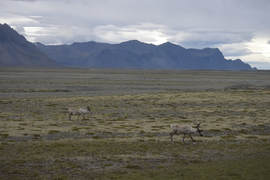 The last wildlife we saw in Iceland were a majestic couple of reindeer. We were not expecting to see any on our trip, then we spotted these two on the side of the road. It really capped off an already great day outside of Vik. We loved watching these animals interact in their natural environment, and going to Iceland in the summertime allowed us to see more animals than we would have otherwise. If you leave the city of Reykjavik, it might be impossible to not see some of Iceland's wonderful wildlife. Iceland has some of the most interesting geology. From glaciers and volcanoes to black sand beaches, there is something different on each side of the country. During our eight day trip around the outskirts of the country, we stopped at several beaches to see different wildlife and environments of every coast we visited. Ytri Tunga was the first beach we visited. We sat on the shores and watched seals play around in the crashing waves, while birds circled around overhead cawing and diving for fish. Saxa Sea Geysir near Stöðvarfjörður was our next viewpoint of the Atlantic Ocean. Unfortunetly, you must go at high tide to see the geysir in its full glory. We were not so lucky, but the water crashing against the jagged rocks was a spectacle all its own. Hvalnes Nature Reserve Beach was one of our favorite places in Iceland. We had the black pebble beach to ourselves for what felt like hours. We chased the monstrous sneaker waves up and down the shoreline as we took pictures of all the bones, shells, and other interesting things they carried onto the shore. Jokulsarlon Glacier Lagoon and The Diamond Beach were unlike any other beach in Iceland and might be the only of its kind in the world. Large chunks of the nearby Vatnajökull Glacier have broken off into the lagoon and washed ashore on the black sand beach. Vik's Reynisfjara Black Sand Beach was the last beach we visited in Iceland. The hexagonal basalt columns, sea caves, and nearby cliffs make this one of the most interesting beaches to explore in Iceland.
 When we started to head down the eastern coast of Iceland, we knew that our eight day road trip was coming to an end. Our plan was to do the most popular regions at the end of our trip to avoid weekend crowds and maybe save the best for last. While the last few days of our adventure did not trump previous regions or experiences, we had a blast hiking across glaciers, playing on black sand beaches, and marveling at waterfalls. East Coast: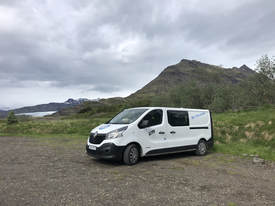 Our trip down the east coast began with us waking up at the Haukafell Campground next to a 'tongue' of Europe’s largest glacier, Vatnajökull. It excited us to see more of the glacier at Jökulsárlón Glacier Lagoon where large chunks of ice have broken off and washed ashore. These fragments give the appearance of, "diamonds on the beach." The contrast between the ice and black sand made The Diamond Beach the most unique beach we visited. We got to see much more of the glacier on the Glacier Hike Tour that we booked through Troll Expeditions and Guide to Iceland. We spent 90 minutes learning about the glacier’s makeup while hiking around the top of 800 year old ice. We even got to taste the ancient ice. 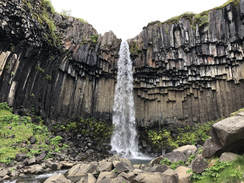 After the tour, we stayed inside Vatnajökulspjódgardur National Park to see Svartifoss. This was one of my favorite waterfalls because of the hexagonal columns that frame the flowing water. We cooked a late night dinner in the parking lot before making it to our campsite for the night.  The Eastern region may have been one of the smaller areas we explored, but it was definitely one of the most eventful and unique. It may be the only area in the world where you can hike on top of a glacier then hike through lush vegetation to a gushing waterfall less than five miles away. There was no doubt in our minds, as we were driving south, that the Eastern region's popularity is well deserved. Little did we know, we were on our way to another region of Iceland deserving of similar popularity and renown. Southern Region: We stayed at the Vik Campsite our first night in the Southern region so that we could get to Reynisfjara Beach as early in the morning as possible. Our plan worked, because we had the giant basalt columns and black sand beach to ourselves for a little while that morning. Next to this marvelous beach is Dryhólaey Cliff. We checked it out quickly before hiking out to the Solheimasandur Plane Wreck. The wreckage was subject to our investigation for a long while, before we hiked back to continue our day in Vik. Two quick stops off the Ring Road would conclude our time in the Vik area. Grandurinn Cave was a fun side stop, while the closed Eyjafjallajökull Volcano shop gave us a quick history of the local eruption in 2010. We continued southeast to hit some of Iceland’s most iconic waterfalls. We saw the 'Walter Mitty Waterfall', Skógafoss, before visiting Seljalandsfoss and its hidden neighbor Gljúfrabúi. The rainbows over Gullfoss were the perfect icing on the proverbial waterfall cake. We ended an already jam-packed day with a different kind of water feature. 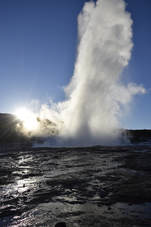 On the Golden Circle lies, Strokkur, a geyser that shoots water 30 meters into the air roughly every 10 minutes. It erupts more frequently and higher than Old Faithful at Yellowstone National Park. It was very fun to sit and watch the geyser boil up and shoot steaming water right over our heads. The next day we had an early morning reservation for a tour of Raufarhólshellir Lava Tunnel. We stepped back in time almost 5,000 years as we followed our tour guide into the tunnel. We spent roughly an hour inside the tunnel learning about the formation and current state of the tunnel. It was a very unique, intriguing experience. 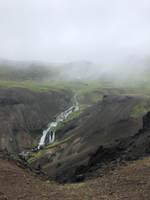 After our tour, we grabbed a quick bite to eat and a warm cup of coffee from Kaffi Kraus. The good meal helped prepare us for our hike to Reykjadalur and the hot river. The hike was gorgeous, and we recommend that you set aside a few hours to really enjoy this spot. We hiked the hour long route but didn't stay long once we'd arrived. We had a reservation at The Blue Lagoon and could not imagine missing it. Even though our trip was coming to an end, we had big smiles on our faces as we left the the Southern region. We had planned our trip perfectly and saved an area jam-packed with gorgeous attractions and guided activities for last. We returned to the Capital region of Iceland with innumerable memories of natural splendor and joyous friendship.
 The further north you go in Iceland, the more sparse the towns and people get. At the same time, the landscape becomes more beautiful and open. After a very busy few days on The Snæfellsnes Peninsula, we were ready to view the wildlife and geography that the northern region had to offer. We started our few days in the northern region in the town of Akureyi. The town has brightly colored buildings that pop in contrast to the mountains that surround them. The harbor had a cruise ship docked, so the streets were packed. We did not give this picturesque, little fishing town the time it deserved. We parked, walked straight to the church, and looked at a few of the surrounding streets. We were in a bit of a hurry to see as many things as possible that day. Our next stop was Godafoss. Its turquoise waterfalls and mossy cliff faces makes it one of the prettiest waterfalls we saw on our trip. When we arrived, we stopped to take pictures on the bridge with a smaller waterfall in the background, but the real masterpiece is hidden behind massive canyon walls. We walked along the trail and were able to get much closer to the fall than we initially expected. When we started to get a little wet from the mist, we called it quits and hopped back in our Kuku Camper to drive toward our next destination. Lake Myvatn held an unexpected landscape. We started by seeing a grassy, green lake that was surrounded by hills. These turned out to be crater lakes! Further down the road, we swam in a slot canyon grotto before visiting Mars on Earth at Hverir. It was the most unique place on the Island that we visited. 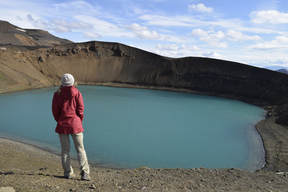 Close to the Lake Myvatn area is Viti Crater. We stopped for a quick picture, but the wind was blowing like crazy, so we decided against walking along the edge. It was a very cool spot that we wish we could’ve had more time to learn about and explore, but we had another waterfall to see. Detifoss is Europe’s most powerful waterfall. It has 500 cubic meters of water falling over its 150 foot drop every second. We came in on the west side of the river where there is a nice pathway and viewing platform. If you come in on the east, you can walk right up to the raging water. We were truly impressed with the overwhelming size of this waterfall. We drove quite a long way off of the ring road to see puffins at our next stop in Borgarfardarhöfn. The hour or so journey up the mountain was narrow and gravelly but absolutely worth the pictures we got. You can see more of my pictures in our gallery, here. 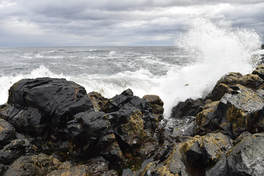 When we got back on the Ring Road, we attempted to see the Saxa Sea Geysir which actually isn't a geyser at all. It’s a rock formation that blasts water into the air. Unfortunately, we didn't go during high tide, so we had a hard time finding the formation. We think we saw it, but we don’t actually know if it was the correct place. 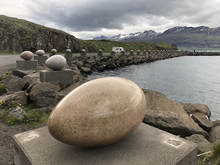 We continued down the coast and stopped in the town of Djúpivogur to see the Eggin í Gledivik sculptures.These sculptures of Iceland’s native bird eggs are very interesting, but we ended up stopping at The Gallery of Freevilli for the most interesting stop of our trip. We looked at the collections of gemstones, bone, and carvings while talking to the owner, before we hopped back in the car for another one of our favorite stops on the trip. Hvalnes Nature Preserve was an unexpectedly fun and interesting shoreline. For almost an hour, we stumbled around on the black gravel beach, looked at the washed up shells and carcasses, and ran from sneaker waves. We laughed so hard at one another as we tried to run from the waves. It was our favorite beach on the trip if not our favorite spot overall.  After all of our excitement on the beach, we had worked up quite an appetite. We stopped in the 'langoustine capital of the north', Höfn, in Hornafirði Fjord. We had some lobster rolls and deep fried hot dogs at Hafnarbúdin. After the great meal, we spent the last bit of our time in the northern region at our campsite in Haukafell. Our two days in the northern region of Iceland were jam packed with things to do and places to see. We came across waterfalls, beautiful wildlife, stunning landscapes, and delicious food. Though northern Iceland is not as popular as the southern region, there is no doubt in my mind that it is just as wonderful, diverse, and intriguing as any other region.
 The Snӕfellsnes Peninsula is not on Iceland’s ring road, but it is well worth a detour. Taylor, Kendall, and I had planned to explore this peninsula from the first day of planning. Not only would we visit our first hot spring, we would visit our first Icelandic national park, see seals in the wild for the first time, and stand atop a volcanic crater for the first time. Our first stop was once a small hot spring called Landbrotalaug. The wind cut cold, but steeping in the hot water could not have been more relaxing and comfortable. The spring can become crowded, but luckily we did not have to wait to hop in at 6:30 on a Friday evening. We could not spend too much time at the spring, but the short dip was an intoxicating experience.  Our next stop would be a quick trip to Ölkelduvatn (or mineral spring) to fill up our water bottles. The spring contains calcium, potassium, sodium, magnesium, iron, fluorine, chlorine, sulfate, bicarbonate, and carbon dioxide in astronomical amounts. The water tastes like very strong carbonated water without the fizz. It is suggested that you leave 200 Icelandic krona (~$2) in a payment box for using the spring. Taylor and Kendall didn't care for the taste, but I was able to finish what we collected. The Ytri Tunga beach is known for hosting its very own seal colony, and we had to stop to see if they were lounging on the shore. After parking, we walked westward along the beach to where a few more visitors had been enjoying the company of seven skeptical seals. The seals were a joy to watch, although their playfulness would often be disrupted by glances to be sure that we hadn’t moved any closer. Chances are supposedly best to see the seals in June and July, and we were all glad to have made the stop. Our plan was to stop for the night in Arnarstapi, but we were quickly informed that there were no spots available. We decided, instead, to view the Gatklettur rock arch and keep pushing onward toward Snӕfellsjökull National Park. The next stop we made was at the Londrangar basalt cliffs where we were drawn to a group of photographers shooting a group of huddled penguins. Once we’d marveled at the unexpected sight of penguins and struggled to take pictures from the far distance, we had a quick parking lot meal and headed for the last stop of the evening. One of the windyest stops of the entire trip, Saxhóll Crater was an uncomfortable but beautiful location. A short climb up a set of metal stairs around 1:30 AM took us to the very top of the crater where we could see the interior of the caldera and miles of the surrounding landscape. One of my favorite activities in Iceland was attempting to mentally simulate the history of each landscape we encountered, and this ancient lava spout was one of my favorites to try to wrap my head around. 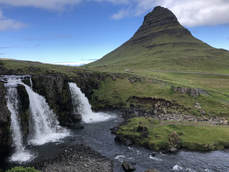 Wrapping my head around the next attraction wasn’t as difficult, but the beauty of a waterfall and mountain combination is something special. Some of the most iconic Icelandic pictures frame Kirkjufell and Kirkjufellfoss. Kirkjufellfoss alone may not stand out among the many Icelandic waterfalls, but the two in concert are exemplary of Iceland’s beauty. The final geological wonder we came to on the Snӕfellsnes Peninsula was the Berserkjahraun Lava Field. The remains of four local volcanoes blanket more than five square miles of area. Seemingly every inch of the once destructive lava flow now hosts a pale green moss. The incredibly soft moss is totally antithetical to the jagged rocks that are its home. A few of our most unique sights were complements of the Snӕfellsnes Peninsula, and the tour of Iceland would not have been the same without it. From hot springs to seals and an expanse of escaped magma, this detour was full of wonder and beauty. A campsite may be few and far between at times, but a breathtaking view of our Earth’s magnificent features never was.
 Our eight day trip through the land of fire and ice started in the capital city of Reykjavik. Iceland is a country of only 300,000 people, but its tourism industry is absolutely booming. As we wandered around the city on a Thursday afternoon, the streets were filled with people, and every store we went into was overflowing with tourists. We started our day at the iconic Hallgrimskirkja Church. Even though we were being pelted with cold rain, we stood outside in awe at this house of worship's architecture. The inside of the church was just as beautiful as the outside. The large chapel was filled with sounds from giant organ pipes. The sounds bounced off the high-arched ceiling and stained glass windows as a church member played.  After we sat and took in the beautiful notes, we went back outside to see the statue out front. Viking history and memories of Leif Erickson are found all over the country, but it is especially prominent in the capitol city. After reading the commemoration to the country’s most famous explorer, we headed to the Sun Voyager Structure to see more monuments to explorers.  The abstract, stainless steel structure is on the Atlantic Ocean and symbolizes the native roots for exploration and discovery. The Sun Voyager was created to encompass the idea of new lands yet to be found and the promise of home, freedom, and progress. From the structure we could see the Harpa Concert Hall which was our next stop.  The modern design of the Harpa Concert Hall stands in contrast to the historic city that surrounds it. The design of the façade is very meticulous and strategically planned. The more I read about the architecture behind the oblong hexagonal sides, the more interesting the building became. They were created to mimic the basalt columns that are famous to the country, and each polyhedron fits together perfectly.  Some panes seem to be random, but they are strategically placed to reflect sunlight in different ways during different times of the day and year. Unfortunately, you cannot see the inside of the concert hall without purchasing a tour. There was an upcoming performance, so we weren’t able to see the concert hall itself. 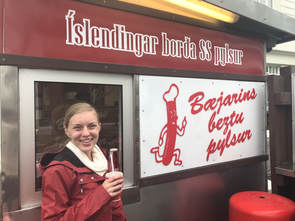 We had worked up quite an appetite by this point, so we went on a hunt for what we had heard were Reykjavik’s best hotdogs. After a quick walk around the Old Harbor, we found the small station that is Bajarins Beztu Pulsur, and we were so glad we did. Our bellies were filled with cheesy hot dogs and coca cola just as celebrities like Anthony Bourdain's, Bill Clinton's, and Princess Diana's had been before. 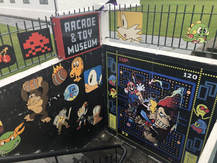 At this point, we had done almost all of the things to do in the city that I had seen online, but we kept strolling around looking at street art and brightly colored buildings. We were glad we kept wandering, because we stumbled upon the Arcade & Toy Museum. The entrance is underground and barely visible from the street. For a small price, roughly $10 a person, we played old-school games like Pac-Man, Galaga, Street Fighter, and pinball for 30 fun filled minutes. When our time was up, we walked across the street to check out some heavy metal punk music that we could hear from the other side. The sounds were coming from the underground Punk Museum, but since we had just paid for the arcade games, we chose not to pay the entrance fee. We kept walking around and stumbled upon the last thing on our loosely planned itinerary, The Lebowski Bar.  We only stayed at this great, cult movie themed bar for a few beers then went back on a quest for an inexpensive bite to eat. Weirdly enough, we ended up in The Irish Pub, because it was advertising cheap fish and chips. That’s all I wanted for dinner, and we decided it was time to head to our Airbnb and get a good night’s sleep after filling up on good beer and decent food. Before we caught the bus home, we grabbed desert at the Volcano Crepes food truck at the bus stop. We topped our night off with a Nutella, chocolate, banana, and strawberry crepe. We got on the bus and knew our trip was going to be great if it were anything close to our day in the city. |
Talkin' 'bout Tacos:
I'm Taylor, aka Tacos! I am sharing my journeys and experiences from across the world hoping to inspire travel and adventure in all who read. Archives
June 2024
|
